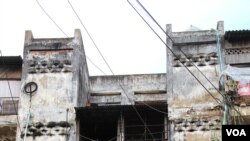They call it the White Building. But the faded concrete walls jut out toward the road in Phnom Penh like a soot-covered ghost from Cambodia's past.
Children and laundry can be seen on the bare stairwells of the historic apartment building where nearly 2,500 mostly low-income residents are facing the possibility of eviction.
Earlier this month, Phnom Penh Governor Pa Socheatvong was quoted as saying the White Building is being condemned and needs to be demolished, and that residents could be moved to the Chroy Changva district in northern Phnom Penh.
But city spokesman Long Dimanche tried to calm frayed nerves this week by saying the governor was misquoted and that the building, located just south of the Royal Palace, is not facing imminent destruction.
Still, residents say they continue to be worried.
Faded Icon
The White Building was constructed in 1963 from plans by architects Lu Ban Hap and Vladimir Bodiansky. It has around 470 apartments and was used by members of King Norodom Sihanouk’s government. It is considered a prime example of the New Khmer architecture movement, developed by architect Vann Molyvann.
Today, about 600 families live there. The residents are mostly poor civil servants, artists, dancers, teachers and street vendors.
Opponents of the building’s destruction say it should be preserved as a historic site.
“The building’s shape looks good,” said Ee Samrom, executive director of Sahmakum Teang Tnaut. “The government should send inspectors to inspect the building with participation from civil society and residents. What worries me the most is that if the plan is true, people there might face same future as other communities, such as Boeung Kak, Borei Keila, and so on. The government always promises to do good things, but in reality they don’t.”
Inspectors Wanted
Meurn Sopha, who has lived in the White Building since 1979, said she has not seen any government inspectors yet.
“I’m quite worried, because we live happily,” she said. “We are not against the government development, but wish to remain here because we don’t know about the new place.”
Hem Lem, who rents a room in the White Building after he and his family were forcibly evicted from the Dey Krahorm community a few years ago, said he’s worried about the same thing again.
“We are poor and can only afford to rent a cheap place like at this White Building,” he said. “Without this building a poor family like mine won’t be able to stay here. People are worried that they would be dumped at a place where there is no water and school; that’s why they don’t want to leave.”
Pen Sereypagna, an architect who used to work on some of Vann Molyvann’s projects, said Phnom Penh will lose a part of its identity if the White Building is demolished.
Long Dimanche said on Monday that the city does not plan to knock down the building.
“How can I explain to you a plan we don’t even have?” he said. “It’s a misunderstanding.”
Sung Sochara, deputy director of the municipal department of land management and urban planning, said municipal inspectors have been sent to inspect the building, but he declined to elaborate.
This report was produced in collaboration with the VOA Khmer service.






